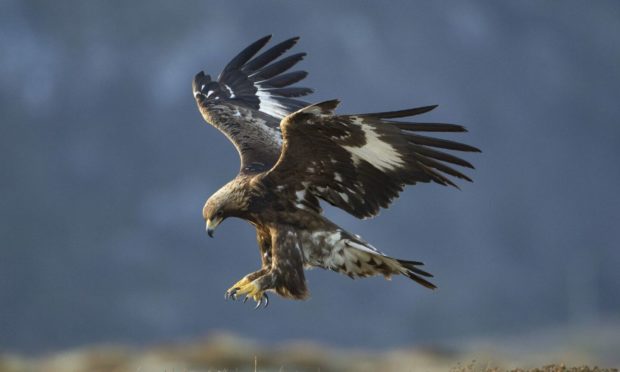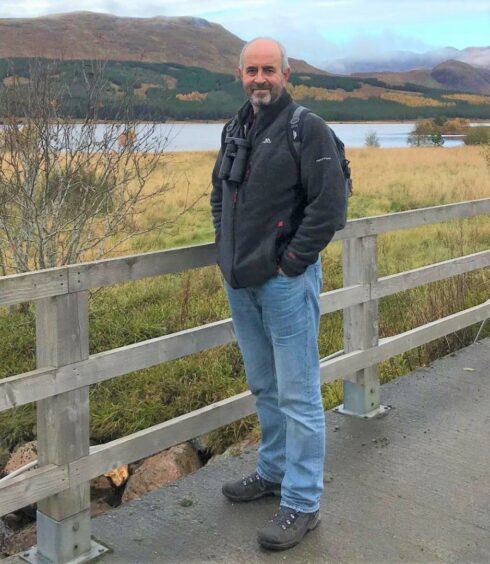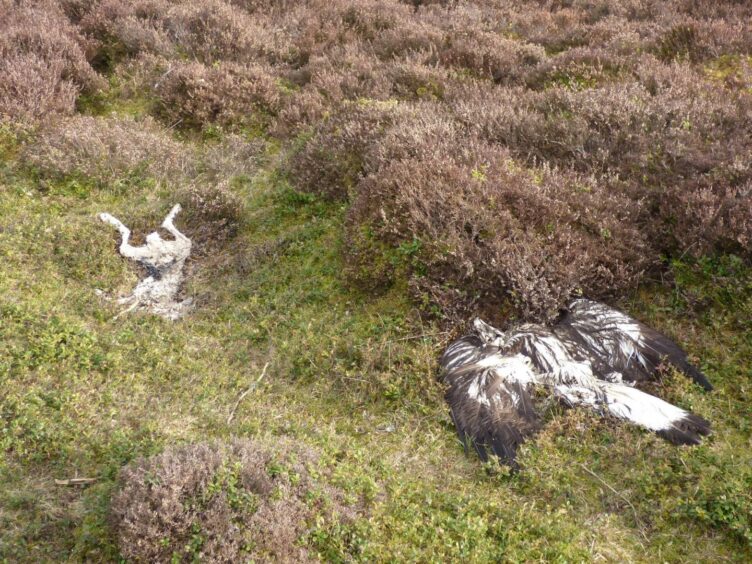Bird crime soared across the UK in 2020, and RSPB believes Scotland’s native birds of prey will continue to be persecuted.
Birds of prey such as hawks, eagles, kites, buzzards, harriers, falcons and owls are protected by the Wildlife and Countryside Act 1981.
The RSPB’s annual report revealed that 2020 was the worst year on record for bird crime across the UK.
There were 137 known and confirmed incidents of birds of prey being killed, the highest number in 30 years.
This trend has continued in 2021 according to Ian Thomson, RSPB Scotland’s head of investigations.
He said: “Bird crime covers a whole manner of crimes against wild birds, but what is particularly of concern are those crimes that have an impact on the populations and ranges of a variety of species.”
According to Mr Thomson bird crime, also known as raptor persecution, is particularly rife in the north-east, with the hen harrier population being a fraction of what it was 20 years ago.
He also explained that golden eagles are only occupying around a third of the breeding territories that they ought to, meanwhile peregrines have largely disappeared from the uplands in the north-east.
Mr Thomson believes that these low population numbers are largely down to the persecution of birds of prey for the intense land management of grouse moors.
Birds of prey are at the top of the food chain and they hunt and eat grouse and pheasants. In an attempt to maximise the number of game birds available for clients to shoot, grouse moor managers will eliminate any threats to their birds.
This can include burning patches of heather moorland and releasing clouds of smoke into the air, leaving medicated grit out in the open and hare baiting.
The National Golden Eagle Survey shows that across Scotland the population as a whole is doing well and that there are significant increases in the west where there are no grouse moors.
Mr Thomson said it is the east of Scotland where the populations are a fraction of what they should be.
Bird crime happens ‘out of sight, out of mind’
Scientific reports show that the illegal persecution of golden eagles, hen harriers, red kites and peregrines are largely happening in areas managed for game bird shooting.
“Unfortunately, these findings are largely happening in the middle of nowhere,” Mr Thomson said, “out of sight out of mind, where witnesses are very far and few between.
“But, occasionally, an incident occurs that is detected. In 2020 about a week into lockdown when the entire population of the country was told to stay indoors or to exercise within 5 miles of your house, we had a young white-tailed eagle poisoned on a grouse moor in Strathdon, in an area with an appalling history of crimes against birds of prey going back 10 plus years.”
Mr Thomson explained there have been cases of birds of satellite-tagged birds disappearing under “suspicious circumstances”.
In March a golden eagle was illegally poisoned on the Ivercauld Estate, a grouse moor in the Cairngorms.
Last year, a satellite transmitter that had been fitted on a golden eagle was found at the side of a river. It was wrapped in lead sheeting and thrown into the river where it lay for four years until a walker found it on the bank.
Mr Thomson said: “This is the efforts that people are going to cover up these crimes, they don’t want to be caught.
“The problem is as I say these crimes are seldom witnessed, to actually get any idea of the scale of it we’re really depending on doing population studies.
“We’re never going to find all the victims because needless to say if someone shoots a golden eagle they’re not going to leave it around for the RSPB or the police or a hillwalker to find. These crimes are being covered up.”
Scotland’s birds face challenges ‘just surviving’
The RSPB Scotland’s head of investigations explained that there are other factors that have impacted the populations of birds of prey.
He said that all birds face challenges “just surviving”, through natural mortality, starvation, and loss of habitat due to the intensification of land management or agriculture.
Because of this populations are much lower than what would be ideal, and so deliberate and illegal killing is adding extra strain to the populations.
As well as being important for biodiversity, birds of prey are an attraction for tourists visiting Scotland.
People interested in photography travel from all over the world to capture Scottish wildlife, bringing millions to the economy.
🦅🔭So sorry not to be able to run @MullEagleWatch @CraignureGC⛳️this year #COVIDー19 but keep in touch with what we hope will be happening at Scalla & Anna's nest via this fabulous live nest camera courtesy of @LDF_lv Warning: it’s compulsive viewing!🎥💻https://t.co/dbtem5lhWX pic.twitter.com/83HTQl8sTQ
— Mull Eagle Watch (@MullEagleWatch) April 1, 2020
Mr Thomson highlighted that on the Isle of Mull, there is around £5 million a year that goes into the island from people going to see white-tailed eagles.
The Scottish Government plan to introduce licensing to grouse moors which Mr Thomson described as a “game-changer”.
He believes the loss of a license to shoot will introduce a significant deterrent to the estates that do persecute birds of prey.
“There are places you wouldn’t want to take your dog for a walk in case it gets caught in a trap or eats something poisonous,” he said. “It’s not just birds that are dying it’s people’s pets.
“Perish the thought that someday some small child will come into contact with chemicals like this, it could have absolutely devastating effects. It’s not only illegal but it’s reckless and indiscriminate.”


